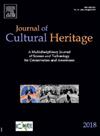The Mappa mundi of Albi: Insight into the manufacturing, life and conservation state of an 8th century world map
IF 3.3
2区 综合性期刊
0 ARCHAEOLOGY
引用次数: 0
Abstract
The Mappa mundi of Albi is one of the oldest examples of spatial representation of the Western world. The small map conserved on the verso of folio 57 in manuscript 29 of the Médiathèque Pierre Amalric in Albi (France) was drawn on parchment, probably made in the second half of the 8th century, somewhere between south-western France and northern Spain, maybe in Albi itself. Because of its exceptional importance for the history of space representation, the map, together with the Index of seas and winds facing it, on the recto of folio 58, was recorded in the UNESCO Memory of the World Register in 2015. The detailed study published here has examined the manuscript’s structure and characterised the different constitutive materials. Observations and physicochemical analyses were performed on the map and the index, from the micro to the macroscale, combining optical microscopy, XRF, FORS, FTIR, and micro-Raman spectroscopy, hyperspectral imaging, proteomic analysis, and non-linear optical microscopy. Three manuscripts conserved at the same library or suspected to have been produced in the scriptorium of Albi have also been examined for comparisons. This material investigation complements the historical studies of the map by shedding new light on the manufacturing, life, and conservation state of this exceptional document.

阿尔比的世界地图:对8世纪世界地图的制作、生活和保存状况的洞察
阿尔比的世界地图是西方世界空间表现的最古老的例子之一。保存在法国阿尔比(Albi)的《mdiathques Pierre Amalric》手稿29页第57页反面的小地图是用羊皮纸绘制的,可能是在8世纪下半叶,在法国西南部和西班牙北部之间的某个地方,也许就在阿尔比本身。由于其在空间表现史上的特殊重要性,这幅地图以及对着它的海洋和风指数(位于第58页的正下方)于2015年被列入联合国教科文组织《世界记忆名录》。这里发表的详细研究已经检查了手稿的结构,并描述了不同的本构材料。结合光学显微镜、XRF、FORS、FTIR、微拉曼光谱、高光谱成像、蛋白质组学分析和非线性光学显微镜,对图谱和指数进行了从微观到宏观的观察和理化分析。还检查了保存在同一图书馆或怀疑是在阿尔比缮写室制作的三份手稿进行比较。这项材料调查补充了地图的历史研究,为这一特殊文件的制作、生活和保存状况提供了新的线索。
本文章由计算机程序翻译,如有差异,请以英文原文为准。
求助全文
约1分钟内获得全文
求助全文
来源期刊

Journal of Cultural Heritage
综合性期刊-材料科学:综合
CiteScore
6.80
自引率
9.70%
发文量
166
审稿时长
52 days
期刊介绍:
The Journal of Cultural Heritage publishes original papers which comprise previously unpublished data and present innovative methods concerning all aspects of science and technology of cultural heritage as well as interpretation and theoretical issues related to preservation.
 求助内容:
求助内容: 应助结果提醒方式:
应助结果提醒方式:


